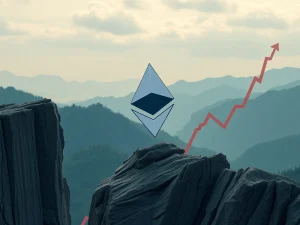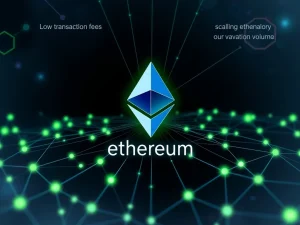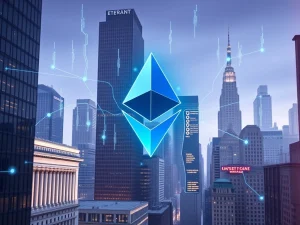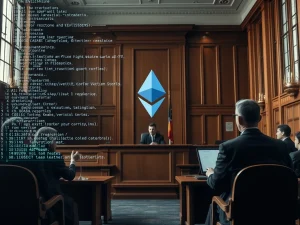Starknet Achieves Breakthrough: Reaches Stage 1 Decentralization and Leads ZK-Rollup TVL

Hey crypto enthusiasts! Ever wonder what’s happening behind the scenes to make Ethereum faster and cheaper? Big news just dropped from Starknet, a major player in the Layer 2 scaling space. They’ve hit a significant decentralization milestone and taken the top spot among ZK-rollups for value locked. Let’s dive into what this means for the future of decentralized applications.
Understanding Starknet’s Stage 1 Decentralization
Decentralization is a core principle of blockchain technology, but achieving it fully on scaling layers takes time. Ethereum co-founder Vitalik Buterin outlined a framework in 2022 with different ‘stages’ for rollups. Starknet just announced it has reached ‘Stage 1’.
What does ‘Stage 1’ decentralization actually mean? Think of it as moving beyond the initial phase where a single team or entity has significant control. For Starknet, reaching Stage 1 involves:
- Operating with limited ‘training wheels’ or oversight.
- Implementing mechanisms to prevent censorship.
- Establishing a security council.
- Using a fully functional validity proof system governed by smart contracts on Ethereum.
While a security council can still intervene in emergencies, the system relies on cryptographic validity proofs submitted to Ethereum to ensure transactions are correct. This is a crucial step towards becoming more robust and trust-minimized.
Starknet Leads the ZK-Rollup TVL Race
Beyond decentralization progress, Starknet has also climbed the ranks in terms of Total Value Locked (TVL). TVL represents the total amount of cryptocurrency deposited in smart contracts on a network, often used as a metric for adoption and activity.
According to data from L2beat, Starknet now boasts a TVL of $629 million. This figure puts it just ahead of ZKsync’s $610 million, making Starknet the largest ZK-rollup network by value locked. This indicates growing confidence and usage of the Starknet platform by users and developers.
It’s worth noting the difference between ZK-rollups and Optimistic rollups:
| Feature | ZK-Rollups (Starknet, ZKsync) | Optimistic Rollups (Arbitrum, Optimism, Base) |
|---|---|---|
| Proof Type | Validity Proofs (Prove transactions are valid) | Fraud Proofs (Assume transactions are valid unless proven otherwise) |
| Withdrawal Time | Typically faster (validity proven on-chain) | Can have challenge periods (fraud proofs) |
| Decentralization Proof | Validity proofs governed by smart contracts | Fraud proofs monitored by watchers |
Starknet’s Place in the Broader Layer 2 Scaling Ecosystem
While leading the ZK-rollup category is a significant achievement, how does Starknet fit into the overall Layer 2 scaling landscape?
The total value secured across all Layer 2 networks on Ethereum is currently around $44.2 billion. This figure fluctuates with crypto market prices, particularly Ether (ETH).
Starknet, with its $629 million TVL, ranks as the fifth-largest Layer 2 network overall. The top four spots are currently held by Optimistic rollups: Arbitrum One, OP Mainnet, Base, and Linea. Interestingly, all of these top Optimistic rollups have also reached Stage 1 decentralization, utilizing fraud proofs as their security mechanism.
The Coinbase-backed network, Base, currently leads the entire Layer 2 sector with a substantial $14.7 billion in TVL, representing about 33% of the total market share. Starknet’s market share is comparatively smaller at 1.4%, highlighting the significant growth potential within the ecosystem.
What’s Next for Ethereum Decentralization?
Reaching Stage 1 is a major step, but it’s not the final destination. The ultimate goal for Layer 2 networks, including Starknet, is to reach ‘Stage 2’ decentralization. This stage signifies a network that is fully autonomous and community-governed, with no remaining ‘training wheels’.
According to L2beat, only a handful of smaller Layer 2 platforms have achieved Stage 2 so far. This underscores the complexity and ongoing work required to build truly decentralized and secure scaling solutions for Ethereum.
Eli Ben-Sasson, co-founder and CEO of StarkWare, the company behind Starknet, stated their commitment: “Our goal is for the training wheels to come off completely and to reach Stage 2 decentralization on Ethereum, and simultaneously steam forward with our work on Bitcoin too.” This indicates a long-term vision for Starknet’s role in decentralized technology.
Conclusion: A Breakthrough for Starknet and ZK-Rollups
Starknet’s achievement of Stage 1 Ethereum decentralization and its rise to become the leading ZK-rollup by TVL marks a significant milestone. It demonstrates progress in building robust, trust-minimized scaling solutions using validity proofs. While the overall Layer 2 scaling market is dominated by Optimistic rollups and giants like Base, Starknet’s position highlights the growing maturity and adoption of ZK technology. The journey to full Stage 2 decentralization is still ongoing for most networks, but Starknet’s progress is a positive sign for the continued evolution of the Ethereum ecosystem.









